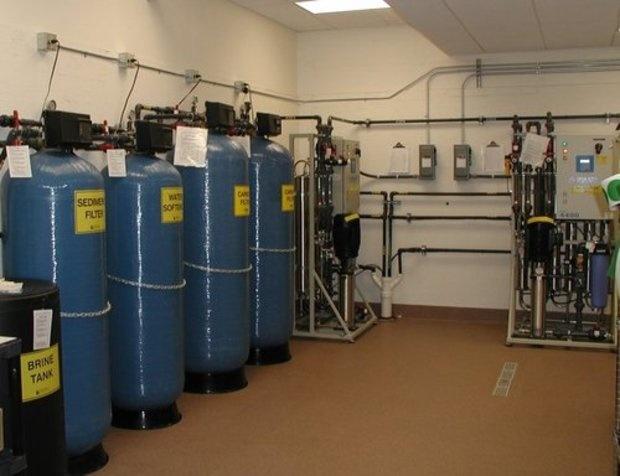Medical procedures such as dialysis or even the machines that clean and sterilize medical equipment use water for a majority of their tasks. However, that is not the kind that a regular hydro water system or a municipal treatment plant would make.
Those waters are filtered and purified specifically for the express purpose they are used, which means different uses call for different types of purification. However, the process itself is largely similar, just done in varying degrees and thresholds of purity. So, let’s get into it.
Regular Water Treatment Systems
The water treatment systems you might have for your town or city use the municipal water treatment method. They are a set of processes and technologies designed to remove impurities and contaminants from water to make it safe and suitable for various purposes, including drinking, industrial use, and other uses where everyday drinking water is viable.
These systems are essential for ensuring access to clean and safe water for communities and industries. The specific components and processes of a water treatment system can vary depending on the source of the water and the intended use. For example, water from freshwater sources is drinkable but might not be from contaminated sources.
Still, the processes of treating water for drinking is largely similar across these industries and municipalities.
Coagulation and Flocculation
This step involves adding chemicals to the water to create floc (clumps of particles). These floc particles attract and bind together with suspended impurities, making it easier to remove them from the water. This allows the less finer particles and pieces of debris to be cleared off in large chunks.
Sedimentation and Filtration
After coagulation and flocculation, water is allowed to sit in a large tank, allowing the heavier floc to settle at the bottom. This process helps to remove larger particles and impurities.
After that, water is passed through various filter media, such as sand, gravel, or activated carbon, to remove smaller particles, including fine sediment, organic matter, and microorganisms. Some activated carbon filters can filter contaminants as fine and small as dust particles.
Disinfection and Chemical Treatment
To kill or inactivate harmful microorganisms like bacteria, viruses, and protozoa, water is disinfected using methods such as chlorination, ultraviolet (UV) radiation, or ozonation.
Some water treatment systems also use chemicals like chlorine, chloramines, or ozone to disinfect and remove residual contaminants. These chemicals also help control taste and odor issues. The pH of water may also be adjusted to make it less corrosive and more suitable for distribution through pipes and plumbing systems.
Softening and Desalination
In areas with hard water, where the water contains high levels of calcium and magnesium ions, water treatment systems may include water softeners to reduce the hardness, which can cause scaling and other issues.
Moreover, in regions with limited fresh water sources, desalination processes like reverse osmosis are used to remove salt and other minerals from seawater or brackish water. Aeration systems introduce air into the water to remove volatile organic compounds, improve taste, and increase the oxygen content.
Sludge Treatment, Quality Control, and More
The solids removed during the sedimentation and filtration processes are typically treated and disposed of, or sometimes reused, to minimize environmental impact. To make sure that treatment doesn’t add to any dangerous thresholds of impurities (which it shouldn’t), water treatment systems include monitoring and testing protocols to ensure that the treated water meets regulatory standards and is safe for consumption or other intended uses.
These systems can be designed for various scales, from small residential systems to large municipal water treatment plants. The choice of treatment processes depends on the specific water source, quality requirements, and the local regulatory standards.
Even the carbon filter in just about every Brita container or at the tip end of the tap where your water comes from has an activated carbon filter attached to it to assist with filtration. Properly treated water helps prevent waterborne diseases, protects public health, and ensures the availability of clean water for a wide range of applications.
How is Ultrapure Water Made?
By contrast to regular water, ultrapure water does not contain additives such as fluoride (to add taste and odor), or chemicals to remove impurities (such as chlorine). Ultrapure water needs to be without both the beneficial nutrients of water and the potential harmful contaminants in it, at least relative to the use case.
That is why ultrapure water for dialysis is always in a highly purified form, essential for ensuring the safety and effectiveness of the dialysis patient. It is produced using specialized dialysis water treatment systems to meet stringent purity standards.
The process begins with selecting a high-quality source of water, usually deionized water or reverse osmosis (RO) water. These source waters are relatively free from impurities compared to tap water.
-
Pre-Filtration: The source water is often pre-filtered to remove particulate matter, sediment, and larger impurities. This step can involve multiple stages of filtration to ensure the source water is as clean as possible.
-
Deionization: To further remove ions and mineral impurities, the source water is passed through ion exchange resins in a deionization (DI) system. This step is crucial for eliminating ions that could be harmful to patients during dialysis.
-
Carbon Filtration: Activated carbon filters may be used to remove organic compounds, chlorine, and other potential contaminants that can affect the taste and odor of the water.
-
Reverse Osmosis (RO): The source water is often subjected to reverse osmosis, which is a process that uses a semipermeable membrane to remove a wide range of impurities, including most dissolved solids, microorganisms, and other contaminants. RO is a key component of ultrapure water production for dialysis.
-
UV or Ozone Treatment: To disinfect and remove any remaining microorganisms and pathogens, ultraviolet (UV) radiation or ozone treatment is commonly used. These methods help ensure the absence of bacteria and viruses in the water.
-
Distribution System: The treated water is then stored in a specially designed distribution system that maintains its purity until it is needed for the dialysis machines.
Throughout the process, ultrapure water for dialysis is subject to continuous monitoring and quality control to ensure that it meets strict purity standards. Regular testing for parameters like conductivity, endotoxin levels, and microbiological contamination is essential, though problematic considering the stored water is not tested but the water before it is send to the storage and distribution tanks is. The water treatment system, including the filters, membranes, and resin beds, requires routine maintenance and periodic replacement to ensure consistent water quality.
Hemodialysis Requires Complete Purity
The ultrapure water produced using these processes is used in hemodialysis machines to create a dialysate solution, which is a specialized fluid that helps remove waste products and excess fluids from a patient’s blood during dialysis treatment. The high purity of the water is crucial to prevent the introduction of contaminants into the patient’s bloodstream and to maintain the safety and effectiveness of the dialysis procedure.
Because of the critical role of ultrapure water in dialysis, water treatment systems for this purpose must adhere to strict regulations and guidelines to ensure patient safety and treatment efficacy. The high cost, high volume of water used, ratio of low volume of ultrapure water produced, maintenance require, and frequency of maintenance between each use is something that needs to be worked on to properly and effectively meet regulatory standards, as current systems are generally lacking in providing effective maintenance and making it cost effective as well.




